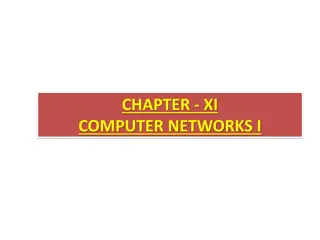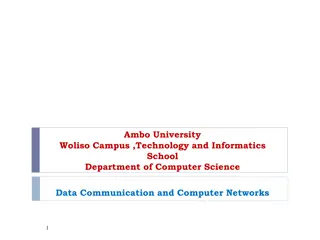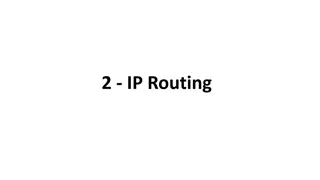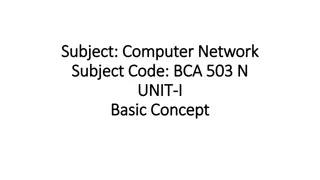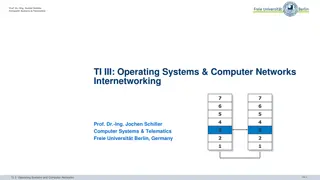Understanding Computer Networks and Communication Methods Through History
Explore the concept of computer networks, how data is transmitted between computers, historic communication methods, common daily activities using computer networks, key milestones in internet history, and more in this informative lesson. Discover the evolution of communication from carrier pigeons to emails and the impact of technologies like the internet and mobile phones on connectivity.
Download Presentation

Please find below an Image/Link to download the presentation.
The content on the website is provided AS IS for your information and personal use only. It may not be sold, licensed, or shared on other websites without obtaining consent from the author. Download presentation by click this link. If you encounter any issues during the download, it is possible that the publisher has removed the file from their server.
E N D
Presentation Transcript
Computer networks: email example
Objectives In this lesson, you will: Define what a computer network is and explain how data is transmitted between computers across networks 2
Historic communication methods These are all forms of communication. Can you match the name with the image and the year in which they were first used? Telegram 1876 1961 Email 1837 Carrier pigeon 1791 1167 Telephone Semaphore 3
Activity 1 Answers Carrier pigeon Semaphore Telegram 1791 1837 1167 Telephone Email 1876 1961 4
What is a computer network? A computer network is when two or more computers are connected together to allow them to communicate. This brings many benefits, which will be covered later on. 5
Using computer networks What common daily activities do you think use computer networks? Think, pair, share 6
How many common daily activities do you think use computer networks? Morning: music playing via a Bluetooth speaker, asking Alexa for the weather forecast, controlling your central heating via an app on your phone Evening: Using social media, playing games online Daytime: logging on to a PC for a Computing lesson, accessing files stored on the school network, printing to the library printer, researching a topic on the internet 7
Key milestones Question revisited: How many devices are now connected to the internet? The internet: The first internet was called the ARPANET. Only a few people had access to it initially. World Wide Web: Tim Berners-Lee invented the WWW. 1969 1989 Guidance: There are just under 8 billion people on the planet. 1974 1977 1999 1950 1970 Mini computers: Nokia introduced a mobile phone that could connect to the internet. The first personal computers: IBM and Apple were a couple of the brands releasing PCs. Mainframe computers: Mainframe computers grew in popularity. These were large and expensive. Think, pair, share 8
A message to UK from Australia (part 1) Imagine that you needed to send a message from Australia to UK but no computer networks exist. What methods would you use? What information would you need? Would anyone be involved in relaying the message? Think, pair, share 9
A message to UK from Australia (part 2) Imagine that you needed to send a message from the Australia to the UK and computer networks do exist. What methods would you use? What information would you need? Would anyone be involved in relaying the message? Think, pair, share 10
Message transmission: letters An answer to the first scenario (no computer networks) might have been to write and post a letter. How is a letter sent from Australia to theUK? What steps are involved between putting the letter in the postbox and it arriving at the destination? 11
Message transmission: email Just as a letter does not go directly from the sender to the recipient, the email does not travel from a sender s machine through a cable or into the cloud directly to the recipient s machine. The message is passed on to many mail servers along the way, who help get the message to its destination. 12











